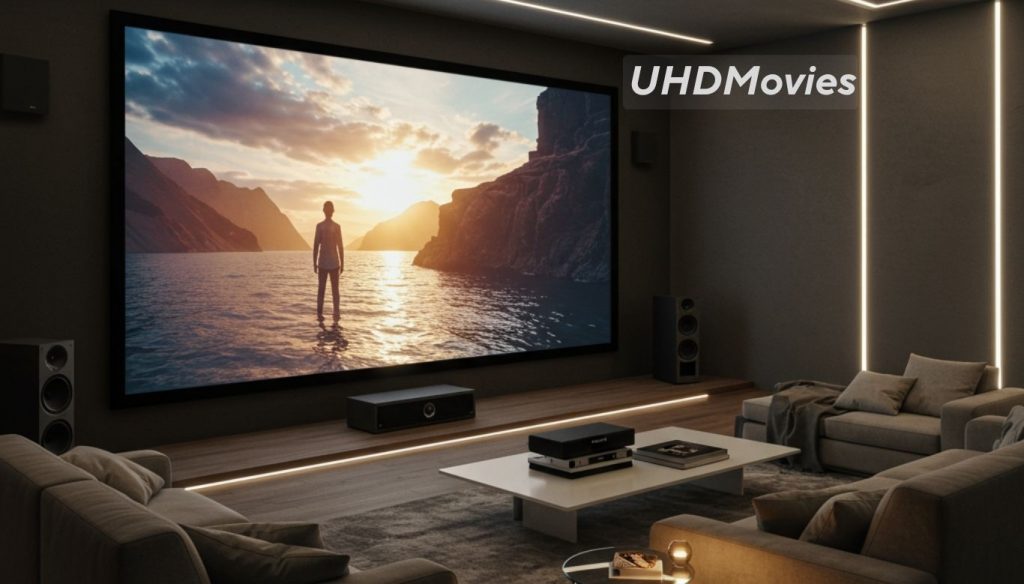UHDMovies is Safe? Complete Guide to Free HD Streaming

The landscape of home entertainment has undergone a remarkable transformation over the decades. From the grainy, standard definition (SD) broadcasts of yesteryear to the crisp, high definition (HD) era, each leap in technology has brought us closer to a truly cinematic experience within our living rooms. Today, we stand at the precipice of the next great evolution: Ultra High Definition (UHD), commonly known as 4K.
UHD, or Ultra High Definition, refers to a display resolution of 3840×2160 pixels. This is a significant jump from the 1920×1080 pixels of Full HD (1080p), meaning a UHD screen boasts four times the total pixels. But UHD is more than just a higher pixel count; it’s a comprehensive suite of technologies designed to deliver an unparalleled visual and auditory feast. UHD movies are not merely an incremental upgrade; they represent the next definitive step in cinematic immersion, bringing the detail, vibrancy, and depth of the big screen right into your home. This article will delve into what makes UHD so revolutionary, what you need to experience it, and where to find the best 4K content.
Understanding UHD Technology
To truly appreciate UHD, it’s essential to understand the key technological components that contribute to its stunning picture quality.
Key Components of UHD
- Resolution (4K): At its core, 4K resolution means a display has 3840 pixels horizontally and 2160 pixels vertically. This translates to over 8 million pixels in total, allowing for incredibly fine detail and a much sharper image, especially noticeable on larger screens or when sitting closer to the display.
- High Dynamic Range (HDR): This is arguably the most impactful feature of UHD. HDR dramatically expands the range of both contrast and color. Instead of simply having more pixels, HDR makes each pixel more meaningful by:
- Deeper Contrast: Delivering brighter whites and significantly darker blacks, revealing details previously lost in shadows or overexposed highlights.
- HDR10, Dolby Vision, HLG (Hybrid Log-Gamma): These are different HDR formats. HDR10 is the open standard, Dolby Vision is a proprietary, dynamic HDR format that optimizes content scene-by-scene, and HLG is primarily used for broadcast television. Each aims to produce a more lifelike image with greater depth.
- Wide Color Gamut (WCG): Beyond just brightness and contrast, WCG allows UHD displays to reproduce a much broader spectrum of colors than standard HD. This means more vibrant, nuanced, and true-to-life hues. The Rec. 2020 standard defines this expanded color space, leading to images that pop with realism.
- Higher Frame Rates (HFR): While not universally adopted, some UHD content and displays support Higher Frame Rates (e.g., 60 frames per second or even 120fps, compared to the traditional 24fps for movies). HFR results in significantly smoother motion, which can be particularly striking in fast-paced action sequences or sports. Films like “The Hobbit” trilogy experimented with HFR to provide a different viewing experience.
The Combined Impact: A More Lifelike and Immersive Viewing Experience
When these technologies—4K resolution, HDR, and WCG—work in concert, the result is truly transformative. The combined impact is a picture that is not just clearer, but also more vibrant, more dynamic, and ultimately, more lifelike. It creates a sense of depth and realism that pulls you into the cinematic world, making for a truly immersive viewing experience that standard HD simply cannot replicate.
Here are some commonly found mirror and proxy sites for UHDMovies:
- uhdmovies.email
uhdmovies.vip
uhdmovies.org
uhdmovies.in
uhdmovies.net
uhdmovies.host
uhdmovies.icu
uhdmovies.cc
uhdmovies.wiki
uhdmovies.uno
uhdmovies.xyz
The Benefits of Watching UHD Movies
Beyond the technical specifications, the real appeal of UHD movies lies in the tangible benefits they bring to your entertainment experience.
Unparalleled Visual Clarity and Detail
With four times the pixels of 1080p, UHD allows you to see textures, subtle facial expressions, and intricate background details that were previously invisible. Whether it’s the weave of a character’s clothing, the individual leaves on a tree, or the fine brushstrokes in a painting, UHD reveals a new layer of visual information, enhancing the sense of depth and realism in every scene.
Superior Color and Contrast
The inclusion of HDR and Wide Color Gamut transforms the visual palette. Colors are richer, more accurate, and more varied, making landscapes more breathtaking and skin tones more natural. The dramatic improvement in contrast means bright scenes are dazzlingly luminous without being washed out, and dark scenes retain incredible detail without becoming a murky black blob. This dynamic range makes every frame feel more impactful.
Immersive Audio (often accompanies UHD)
While UHD primarily refers to video, the premium viewing experience often extends to audio. Many UHD Blu-rays and streaming services offer advanced audio formats like Dolby Atmos and DTS:X. These object-based audio technologies create a three-dimensional soundscape, allowing sounds to move around and above you, further immersing you in the film’s world. Imagine rain falling from above or a helicopter flying overhead – these formats make it feel like you’re truly there.
Future-proofing Your Home Theater Setup
Investing in UHD technology now means your home theater system will be ready for the next generation of content. As more movies, shows, and games are produced in 4K HDR, having compatible equipment ensures you won’t miss out on the highest quality available for years to come.

What You Need to Watch UHD Movies
To fully enjoy UHD movies, you’ll need a compatible setup. Here’s a breakdown of the essential components:
UHD TV/Display
This is the cornerstone of your UHD experience. Your TV must have:
- Native 4K resolution: Ensure the display panel itself has 3840×2160 pixels.
- HDR compatibility: Look for support for HDR10, and ideally Dolby Vision, for the best dynamic range.
- HDMI 2.0a/b or HDMI 2.1 ports: These are crucial for transmitting the large amounts of data required for 4K HDR content. HDMI 2.1 offers even greater bandwidth for future-proofing and higher frame rates.
UHD Blu-ray Player or Streaming Device
You’ll need a source for your 4K content:
- Dedicated UHD Blu-ray players: For the absolute best quality, a dedicated UHD Blu-ray player paired with physical discs offers the highest bitrate and no compression artifacts.
- Streaming devices: Popular options include Apple TV 4K, Roku Ultra, Chromecast with Google TV, and Fire TV Stick 4K. These devices are designed to stream 4K HDR content from various services.
High-Speed Internet Connection (for streaming)
If you plan to stream UHD content, a robust internet connection is vital. Most streaming services recommend a minimum of 25 Mbps (megabits per second) for stable 4K streaming, with higher speeds preferred for optimal performance and to avoid buffering.
HDMI Cables
Don’t overlook your cables! You’ll need High-speed HDMI cables (2.0 or 2.1 certified) to ensure proper transmission of 4K HDR signals. Older, standard HDMI cables may not have sufficient bandwidth, leading to picture dropouts or lower resolution.
Optional: Sound System
While not strictly necessary for UHD video, an enhanced sound system significantly elevates the overall experience:
- AV receiver with HDR/4K passthrough: If you have a separate receiver for your audio, ensure it can pass through 4K HDR video signals without degradation.
- Dolby Atmos/DTS:X compatible speakers: To experience the immersive 3D audio, you’ll need a compatible receiver and speakers, often including upward-firing or ceiling-mounted speakers.
Alternative sites to UHDMovies
- Filmyhit.com Official Site | Watch Free HD Movies Online
- PRMovies Proxy | PRMovies Stream Bollywood & Hollywood Movies in HD
- Movies4u hub | Download Bollywood, Hollywood & South Indian Movies in HD
Where to Find UHD Movies
The good news is that 4K content is becoming increasingly abundant.
UHD Blu-ray Discs
For the discerning cinephile, UHD Blu-ray discs offer the best possible picture and sound quality:
- Best quality: Due to higher bitrates and less compression, UHD Blu-rays typically provide a superior image compared to streaming.
- Availability: New releases are almost always available on UHD Blu-ray, and many catalog titles are being re-released in 4K.
Digital Purchases/Rentals
Many digital storefronts allow you to buy or rent UHD movies:
- Apple TV (iTunes), Google Play Movies & TV, Vudu, FandangoNOW: These platforms offer a growing selection of 4K HDR titles for purchase or rental, often with the convenience of immediate access.
Broadcast/Cable (Limited availability, often upscaled)
While some broadcasters are starting to experiment with 4K, native 4K content on traditional broadcast or cable is still limited. Much of what is advertised as “4K” might be upscaled from a lower resolution.
Tips for the Best UHD Viewing Experience
Once you have your UHD setup, a few adjustments can help you maximize your viewing pleasure.
Optimize TV Settings
Dive into your TV’s picture settings. Experiment with different picture modes (e.g., Cinema, Movie, or Custom) and adjust HDR settings to suit your preferences and room lighting. Many TVs have specific HDR modes that activate automatically when HDR content is detected.
Proper Seating Distance
While 4K allows you to sit closer without seeing individual pixels, there’s an optimal viewing distance that allows your eyes to take in all the detail without strain. Generally, for a fully immersive experience, aim for a distance where the screen fills about 30-40 degrees of your field of view.
Lighting Conditions
For the best contrast and color accuracy, watch UHD content in a dimly lit or dark room. This prevents reflections and allows your eyes to fully appreciate the dynamic range of HDR.
Ensure All Components are UHD/HDR Compatible
Double-check that every link in your chain—from the source device to the cables to the TV—is capable of handling 4K HDR signals. A single incompatible component can bottleneck the entire system, preventing you from experiencing true UHD.
The Future of UHD and Beyond
The evolution of display technology is relentless, and UHD is just another step on that journey.
8K Resolution
While 4K is becoming mainstream, 8K resolution (7680×4320 pixels) TVs are already available. As content creation catches up, 8K will offer even more incredible detail, though its benefits are most apparent on very large screens or at extremely close viewing distances.
Advanced HDR Technologies
Expect further refinements in HDR, with even greater brightness, deeper blacks, and more precise control over dynamic range.
More Immersive Audio Formats
Audio technologies will continue to evolve, offering even more realistic and enveloping soundscapes, potentially integrating more seamlessly with visual cues.
Interactivity and VR/AR Integration
The lines between passive viewing and interactive experiences may blur further, with UHD content potentially incorporating elements of virtual reality (VR) or augmented reality (AR) for truly novel forms of entertainment.
Conclusion
UHD movies represent a significant leap forward in home entertainment, offering an experience that is richer, more detailed, and more immersive than anything that came before. By combining stunning 4K resolution with the transformative power of High Dynamic Range and Wide Color Gamut, UHD brings the magic of the cinema directly into your home.
Investing in UHD technology is not just about keeping up with the latest trends; it’s about making a tangible upgrade to your viewing pleasure. With the right equipment and a growing library of content, you can unlock unparalleled visual clarity, superior color and contrast, and often, incredibly immersive audio. So, prepare to dim the lights, settle into your favorite spot, and enjoy the ultimate cinematic experience right at home.




![Vegamovies 4k : Vegamovies Proxy & Mirror Sites List July 2025 [100% Working]](https://technonguide.com/wp-content/uploads/2025/07/Vegamovies-%E2%80%93-Watch-Latest-Movies-TV-Shows-Online-Free-800x450.jpg)

![Flixtor Movies: Explore Sites on Flixtor to & Alternatives [2025 Updated]](https://technonguide.com/wp-content/uploads/2025/02/Flixtor-Movies-800x450.jpg)